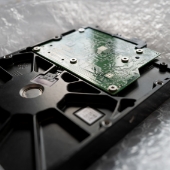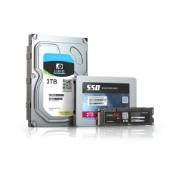 Upgrading your data storage system and can’t choose between hard disk drives (HDDs) and solid-state drives (SSDs)? To help you make the best choice for your business and ensure your data system is optimized, we’ll walk you through the features of HDDs and SSDs, as well as the pros and cons of each.
Upgrading your data storage system and can’t choose between hard disk drives (HDDs) and solid-state drives (SSDs)? To help you make the best choice for your business and ensure your data system is optimized, we’ll walk you through the features of HDDs and SSDs, as well as the pros and cons of each.
What is an HDD?
An HDD is a spinning hard disk that reads and writes data on a metal platter with a magnetic coating. The internals of an HDD look similar to an old record player — there’s a platter or a stack of platters, which spin around a spindle, and an armature called a read-write head. Data is stored onto the platter via tiny magnetic particles.
What is an SSD?
Unlike an HDD, an SSD does not have any internal moving parts. Instead, it uses integrated circuit assemblies to store, retrieve, and cache data. An SSD has two key components: flash memory chips and the controller (i.e., an embedded microprocessor). Flash memory contains storage memory, while the controller executes firmware-level software.
HDD vs. SSD: How are they different?
Let’s compare the two storage devices based on these five categories.
Speed
HDDs take a long time to access data because the disk must spin to find it. They typically have a spinning speed of around 5,400 to 7,200 rotations per minute.
In contrast, SSDs can complete the same task 200% faster since they rely on instantly accessible memory chips. That’s why a computer equipped with an SSD can boot an operating system and load apps much faster than one that uses an HDD. An SSD can copy and move large files at 500 MB per second, while an HDD can do the same at 30–150 MB per second. This means you can store 20 GB of data in less than 10 seconds with an SSD, but you would need at least two minutes with an HDD.
Capacity
Thanks to recent technological advancements, SSDs can now support terabytes of storage, just like HDDs. However, if you compare today’s lowest-priced laptops, you’d see that they’re either equipped with 128 GB SSD or 500 GB HDD. Why is there such a huge difference in storage capacity? It’s because SSDs come with prohibitively high price tags. Therefore, if you require a lot of storage space, HDD is the way to go.
Cost
For the same storage capacity, HDDs are less expensive than SSDs, which is why they’re often bundled in budget laptops and PCs. To keep its price competitive, a budget laptop typically can have only up to 512 GB SSD storage.
Some gaming laptops solve this speed-price dilemma by having both an SSD and an HDD — the SSD is for key applications and the HDD is for data. However, take note that most consumer and business laptops do not have room for multiple storage drives. Fortunately, you can easily find 1 TB external USB hard drives for under $50.
Durability
HDDs are more susceptible to shock and damage because they have various moving parts and components. This means that if you accidentally drop your laptop, your HDD might get damaged and your data will be lost. Moreover, the longer you use your HDD, the more it wears down and eventually ends up failing.
In contrast, because SSDs use a non-mechanical design of flash storage mounted on a circuit board, they are more durable and are better at keeping your data safe.
Noise
An HDD emits some noise when the drive spins back and forth to process data. In contrast, SSDs do not have moving parts, so it does not make any noise at all.
Conclusion
Overall, SSDs are the clear winner over HDDs. While more expensive, an SSD is the faster and far more durable data storage option in the long run.
If your computer can support multiple hard drives, you can use an SSD as the primary storage for your OS, applications, and most-used programs. Meanwhile, you can use an HDD to store pictures, documents, and other files that do not require quick access times and speeds.
Planning to purchase new hardware? Let our experts guide you so you can confidently make the right IT investments. Get in touch with us today.

 Looking to boost your device’s performance? Choosing the right storage drive can make all the difference. In this post, we’ll break down the pros and cons of HDDs and SSDs, so you can find the best option based on your needs and budget.
Looking to boost your device’s performance? Choosing the right storage drive can make all the difference. In this post, we’ll break down the pros and cons of HDDs and SSDs, so you can find the best option based on your needs and budget. When it comes to data storage, two main types of drives dominate the market: hard disk drives (HDDs) and solid-state drives (SSDs). While HDDs, which use spinning disks to read and write data, have been the traditional choice, solid-state drives (SSDs), which rely on flash memory for faster performance and durability, are rapidly gaining popularity. This guide outlines the key differences between the two storage technologies.
When it comes to data storage, two main types of drives dominate the market: hard disk drives (HDDs) and solid-state drives (SSDs). While HDDs, which use spinning disks to read and write data, have been the traditional choice, solid-state drives (SSDs), which rely on flash memory for faster performance and durability, are rapidly gaining popularity. This guide outlines the key differences between the two storage technologies. If you’re looking for a new Mac, you might be wondering if you should get one with a hard disk drive (HDD) or a solid-state drive (SSD). While HDDs are cheaper, SSDs offer many advantages that make them the better choice. Here are some reasons you should get a Mac with an SSD.
If you’re looking for a new Mac, you might be wondering if you should get one with a hard disk drive (HDD) or a solid-state drive (SSD). While HDDs are cheaper, SSDs offer many advantages that make them the better choice. Here are some reasons you should get a Mac with an SSD. Solid-state drives (SSDs) are fast becoming the standard for data storage because of their many advantages over hard disk drives (HDDs). Here are the top five reasons SSDs are better than HDDs for Macs.
Solid-state drives (SSDs) are fast becoming the standard for data storage because of their many advantages over hard disk drives (HDDs). Here are the top five reasons SSDs are better than HDDs for Macs. If your once snappy Mac now feels like it’s dragging its feet, a solid-state drive (SSD) upgrade could be just the thing that will breathe new life into it. But even if your Mac is still running pretty well, the benefits of an SSD upgrade may convince you to make the switch from a hard disk drive (HDD). Here’s a look at some of the key advantages of SSDs over HDDs.
If your once snappy Mac now feels like it’s dragging its feet, a solid-state drive (SSD) upgrade could be just the thing that will breathe new life into it. But even if your Mac is still running pretty well, the benefits of an SSD upgrade may convince you to make the switch from a hard disk drive (HDD). Here’s a look at some of the key advantages of SSDs over HDDs. If you’re in the market for a new computer or laptop, you may be given a choice to configure your system with either a hard disk drive (HDD) or a solid state drive (SSD). Both drives store data but work in different ways. In this blog post, we’ll discuss their differences so you can determine which one is right for you.
If you’re in the market for a new computer or laptop, you may be given a choice to configure your system with either a hard disk drive (HDD) or a solid state drive (SSD). Both drives store data but work in different ways. In this blog post, we’ll discuss their differences so you can determine which one is right for you. Hard disk drives have been the predominant storage device for desktop computers and laptops for a long time. But solid state drives (SSDs) are now quickly becoming the norm. If you’re choosing between the two, it’s important to know their differences so you can get the one that best fits your needs.
Hard disk drives have been the predominant storage device for desktop computers and laptops for a long time. But solid state drives (SSDs) are now quickly becoming the norm. If you’re choosing between the two, it’s important to know their differences so you can get the one that best fits your needs. PCs and laptops typically came with hard disk drives (HDDs), but buyers can now also have the option to configure their system with either HDDs, solid state drives (SSDs), or in some cases both. In this blog, we’ll compare both storage drives so you can make the best decision for your needs.
PCs and laptops typically came with hard disk drives (HDDs), but buyers can now also have the option to configure their system with either HDDs, solid state drives (SSDs), or in some cases both. In this blog, we’ll compare both storage drives so you can make the best decision for your needs.